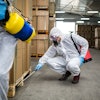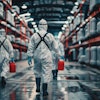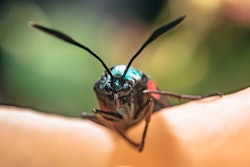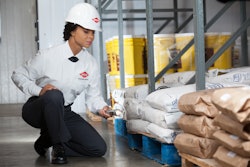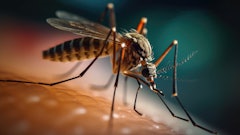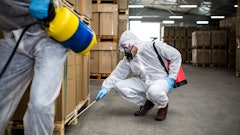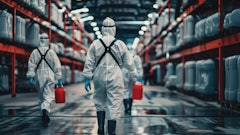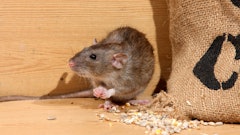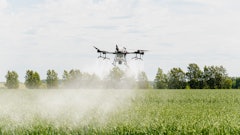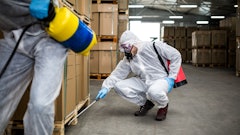
Food safety regulations and audit requirements are abundantly clear on the topic of pest control -- it must be managed preventatively and with the utmost diligence. Exclusion - the use of physical barriers to prevent pests from entering a building in the first place - is fundamental to maintaining food safety standards and supply chain integrity.
The SQF Institute Food Safety Code for Storage and Distribution, Edition 9 states, “Identified pest activity shall not present a risk of contamination to food products, raw materials or packaging,” (12.2.4.3). Most professionals would agree that rodents are not only some of the most notorious pests threatening the food industry, but also the most tenacious. Given the fact rodents eat or contaminate at least 20% of the world's food supply each year, it’s clear that even the smallest level of identified rodent activity presents a risk of contamination to food products. In one year, a single rat can shed more than half a million body hairs, and a mouse can produce up to 18,000 fecal droppings. Once they’re inside, it is already too late.
And, they most certainly are trying to get inside. Rats have been known to gnaw through plastic, wood, aluminum, brick, cement and even lead in search of food and shelter. They can climb wires and rough surfaces, swim considerable distances and tread water for several days. They are not easily deterred, and keeping them out through the use of comprehensive exclusion methods is critical to maintaining food safety standards.
Rats cost the world’s economy billions of dollars every year, and are a primary cause of health inspection and third-party audit failures for good reason -- all rodents carry diseases, including rat bite fever, hantavirus, leptospirosis, salmonellosis, murine typhus and even the bubonic plague.
The SQF Food Safety Code for Storage and Distribution also states, “All external windows, ventilation openings, doors and other openings shall be effectively sealed when closed and proofed against dust, insects, birds and other pests,” (12.1.4.1). Rodents can squeeze through an opening as small as one-fourth inch, which makes access points easy for them to find. Cracks or holes in a building’s foundation and openings where plumbing, gas and electric wiring enters the building are all key targets. Each of these areas should be safeguarded with proper exclusion materials. Caulk, mortar and spray foam, while inexpensive, offer little to no protection against gnawing rodents. Steel wool will rust and degrade over time. The best exclusion materials are made of stainless steel or other permanent elements that won’t degrade over time.
It’s also important that windows, screens and window panes be kept in good repair. As rodents are natural climbers, all trees and branches should be trimmed back, so they don’t provide easy access to the building. Roof lines should be inspected regularly for gaps, and all shingles, ventilators, chimney and vent screens must be in place and undamaged.
Floor joints create vulnerability to rodents as well. Over time, shrinkage while curing, foundation settling and temperature shifts can cause the gaps at joints in concrete to expand. These bigger gaps are often exploited by rodents and other pests for burrowing into and throughout a building. These expanded gaps must be identified and sealed with proper materials.
The SQF Institute Safety Code for Food Manufacturing says, “External doors, including overhead dock doors in food handling areas used for product, pedestrian, or truck access, shall be designed and maintained to prevent pest ingress…” (11.1.5.2). This regulation is critical because exterior personnel doors, garage doors and the many openings surrounding a loading dock are some of the most common rodent targets. Rodent-proof door sweeps are probably the single most important pest management tool for the food industry. The tiny gap beneath an unprotected door is like a red carpet rolled out to welcome in rodents, not to mention outdoor elements and other potential contaminants. Standard rubber door sweeps might offer some protection from the elements, but won’t last the night against even a single determined rodent. Metal brush seals dent and deform over time, leaving gaps that rodents can exploit to gain entry. Specialized rodent-proof door sweeps are paramount to protecting food facilities across every facet of the supply chain.
Garage doors are also highly vulnerable and must be safeguarded with rodent-proof seals. A combination brush seal/rodent-proof seal offers the strongest solution to meeting audit standards. The rodent-proof seal will effectively keep out rodents while the brush seal will help ensure no light passes through, which is often how food safety auditors determine whether doors are at risk of being breached by pests and other environmental conditions and contaminants.
Loading docks are often ground zero for rodent pressure. The moving parts, tiny gaps, heavy foot traffic and equipment wear and tear make them notorious for rodent activity. Effective pest exclusion involves meticulously sealing every single gap surrounding the many working parts. From the top of the loading dock door to the small vertical gap on each side to the gap created by the dock leveler and the often-overlooked opening surrounding the pull chain, rodents will find a way in. The only proper solution is one that involves sealing every single opening with proven, specialized rodent-proof seals. It’s also important that loading docks are well-maintained. If dock levelers are not maintained to manufacturer specifications, rodents can exploit them for weaknesses and gain entry.
Once comprehensive exclusion tools are in place, facilities should be inspected daily for rodent activity. The rate at which rodents contaminate food and the rate at which they multiply is astounding. In one year, rats and mice destroy enough food to feed 200 million people. Employees should be trained to notice signs of pest activity and commended for reporting it.
Supply chain integrity is challenged at every step by relentless rodents. A comprehensive, diligent exclusion plan is fundamental to protecting supply chain integrity and meeting food safety audit standards.



